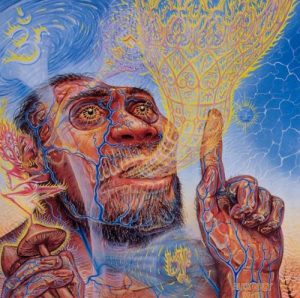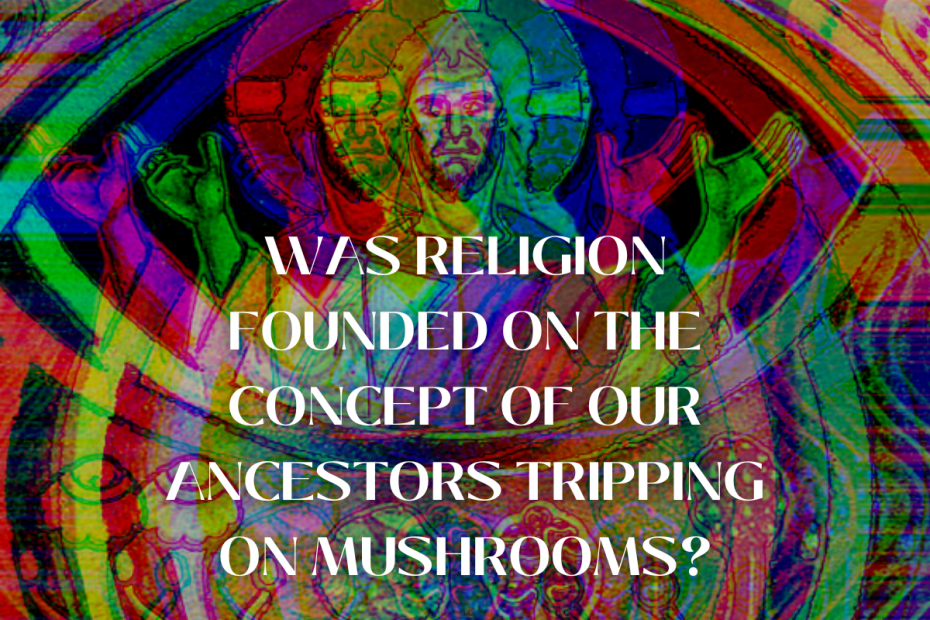It’s no secret that people from all eras and cultures have used hallucinatory drugs to attain exalted states of consciousness, which they take to mean divine understanding. In The Sacred Mushroom and the Cross, John Allegro tried to show that this idea was built into the language and thought of religion from the very earliest times and was still evident in the language and thought of the first Christians.
Much of his argument was based on his research into an ancient drug cult still active in South America today. So was religion founded on the concept of our ancestors tripping on mushrooms? Is Christianity’s use of “spirits” based on shamanic journeying? Is it just a coincidence that many of the religious practices we see in the world today are strikingly similar to shamanistic rituals? And why was it so important for the early Christians to claim that the resurrected Jesus had died for our sins instead of just suggesting that he had experienced a temporary death? Ego death perhaps?
These are all questions that deserve to be explored further and may provide us with some insights into the origins of religion. But what strikes me now is not so much whether Allegro was right about all of this, but the fact that he didn’t notice what to me seems far more obvious: the same sort of thing seems to go on in popular culture all the time! I’m not saying that this is necessarily the case; I’m just trying to provoke some thought by pointing out that many creative artists feel that their experiences were somehow supernatural or mystical, whether they took them in the form of psychedelics, plant medicine, meditation or what have you.
If anything, this suggests something much deeper is going on – perhaps having to do with a collective consciousness shared by all human beings throughout the ages. As far as I can see, most mainstream religions nowadays tend to frown upon this sort of thing as disruptive and potentially dangerous to social cohesion. In contrast, older shamanic traditions see hallucinogens and entheogens as a source of wisdom and understanding.
Ayahuasca for example is a potent amazonian sacred brew made from leaves of the Psychotria viridis shrub combined with the stalks of the Banisteriopsis caapi vine and sometimes with other psychotropic plants native to the Amazon basin. This psychedelic infusion has a long history of ceremonial consumption by various indigenous peoples throughout South America. It allows the soul to be freed to wander without corporeal confinement, otherwise known as an OBE (out-of-body experience).

Mural of Adam and Eve and the serpent at the Tree of Knowledge, Mural from St. Michael’s Church, Hildesheim Germany 1192 AD
Why Religion?
The “unmistakable urge to believe in the existence of a supernatural world, order and meaning” concept is commonly attributed to the German philosopher Friedrich Nietzsche. However, it appears much earlier in history, as Nietzsche himself pointed out in a passage from his book The Antichrist (1895). Nietzsche was referring there to Heinrich Heine’s 1836 poem “Der Antichrist”. It begins: “Once upon a time there lived a poor cobbler who found it hard to make ends meet. For years he sweated over his shoes until at last, he had invented straps so they wouldn’t wear out too soon. But alas! his wife thought his work was vain and silly! She would have nothing to do with them saying they smacked of witchcraft and sorcery!”
Religion is one such example – invented by humans as a way to explain our experiences regarding the perceived supernatural. And it may come as no surprise that this concept can be traced back to our ancestors’ documented use of psychoactive mushrooms.

The Plaincourault fresco.
Religion is likely the result of the need for humans to explain the inexplicable. In other words, religion is a product of the human experience so Religion, in all its many forms, exists to explain the unexplainable, to explain the supernatural. Why do we need to do this? What is the purpose of religion? Simply put, humans have sought answers to questions they have been asking since the dawn of time. We seek to understand the world around us and to make sense of our existence within it. And, as the following passage so eloquently points out, religion serves a very important function: It may be true that we are born naked, helpless, and ignorant of good and evil; but, if we are clever and lucky, we do not die so.
The fact that we are born with our curiosity unsatisfied is the most obvious and important of all the facts about ourselves. Our curiosity is the desire to know why things are as they are and why we are the way we are. So If we do not find satisfactory answers to these questions, what is the point of our existence you may ask?
“The shaman is not merely a sick man or a madman…he is a sick man who has healed himself.” ~ Terrence McKenna
What is a Shaman?
Shamanic practices have been observed in many societies around the world. Many anthropologists believe that shamanism may be as old as humanity itself. A shaman is a person who uses various techniques, including entheogenic substances, to enter altered states of consciousness.
Visions or other supernatural phenomena often accompany these altered states. The shaman may then use this information to diagnose and treat various ailments and to aid the community in various ways. Drawing from the work of ethnobotanists such as Richard Evans Schultes and R. Gordon Wasson, it is believed that early humans consumed psilocybin mushrooms to gain insight into their place within the universe. This practice likely led to the first concept of a “shamanic worldview.”

The Siberian Shaman, Tatiana.
Entheogens: The Origins of the Sacred Mushroom Use
Entheogen comes from the Greek word entheos, which means “the god (divine) within” and gen, which means “creates” or “generates.” So the literal translation of entheogen is “generating the god within.” An entheogen is a substance that generates the divine within us. It is a substance that causes us to realise the god within.
Entheogens are substances that can achieve this. They can be used for various purposes, including meditation, white and black magic, divination, sensory deprivation, asceticism, prayer, trance, drumming, and chanting. The Hippie movement used entheogens in the 1960s in addition to psychedelic art, binaural beats, sensory deprivation tanks (The movie altered states 1980), and music. Indigenous peoples have used them for thousands of years. In some countries, traditional entheogen use is permitted. The ancient shamanic use of Amanita muscaria in Siberia is well documented. Despite governmental oppression against its use, many still refuse to accept the authorized state religion and continue the shamanic traditions in secret.
The use of psychoactive plants and fungi as religious agents dates back thousands of years. Many anthropologists believe that using psychoactive substances as religious agents dates back even further than the dawn of humanity. Many also believe that the use of entheogens was likely one of our species’ earliest forms of religious practice. This is because these entheogenic plants and substances can alter our state of consciousness, allowing for greater insight into the nature of our reality and beyond. These substances are also known as the “food of the gods.”
The Psychedelic Revolution: How Consciousness-Expanding Drugs were Discovered in the West.
In the 1950s, there was a major shift in the Western world as many researchers began investigating the therapeutic properties of psychedelics. These researchers were looking to find non-addictive treatments for mental illnesses such as anxiety and depression.
In 1957, Saskatchewan-based psychiatrist Humphry Osmond coined the term psychedelic. Because LSD and mescaline (from the peyote cactus) assisted guided trips, mental health therapies were an alternative to long-term care in asylums.
Between 1950 and 1961, over 1,000 scientific papers and Medical journals were published on LSD and its hallucinogenic properties. Little did they know that they were on the cusp of a paradigm shift in human consciousness. Unfortunately, the United States government viewed these substances as dangerous and outlawed their use. This led many researchers to begin researching the black market, as the research and purchase of these substances were also made illegal as they still are to this day.
“Psychedelics are illegal not because a loving government is concerned that you may jump out of a third story window. Psychedelics are illegal because they dissolve opinion structures and culturally laid down models of behaviour and information processing. They open you up to the possibility that everything you know is wrong.”
― Terence McKenna

Summary
Religion is one such example – invented by humans as a way to explain our experiences regarding the supernatural. And it may come as no surprise that this concept can be traced back to our ancestors’ documented use of psychoactive mushrooms and entheogens. The use of psychoactive mushrooms was likely one of our species’ earliest forms of religious practice. This is because these agents can alter the state of consciousness, allowing for greater insight into the nature of reality.
Unfortunately, the United States government viewed these substances as dangerous and outlawed their use. This led many researchers to begin researching the black market, as the research and purchase of these substances were also made illegal. This research eventually led to the development of the psychedelic revolution, which may very well be the greatest discovery in human history. And, as the following passage so eloquently points out, the psychedelic revolution offers more than just a way to “lose your mind.”
Terence McKenna postulated that, as the jungles receded near the end of the most recent ice age and savannas and grasslands emerged, a branch of our arboreal primate ancestors left the forest and began living in the open. They experimented with new dietary varieties in this new environment, consuming psilocybin-containing mushrooms that grew near dung of ungulate herds in the savannas and grasslands. McKenna referenced the research of Roland L. Fisher and claimed that psilocybin at low doses enhanced visual acuity and conferred an adaptive advantage. They conferred selective evolutionary advantages at slightly larger doses, including sexual arousal and glossolalia. His theory is known as the “Stoned Ape Theory.”
Related Books and Articles:
Entheogens in Christian art: Wasson, Allegro, and the Psychedelic Gospels
The Holy Mushroom: Evidence of Mushrooms in Judeo-Christianity
Terence McKenna – Food of the Gods A Radical History of Plants, Drugs and Human Evolution

Thanks for your blog, nice to read. Do not stop.
Bookmarked!!, I like your web site!
I found your article to be thought-provoking and inspiring. Thanks for challenging my perspective!